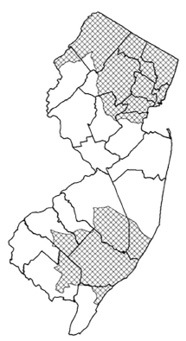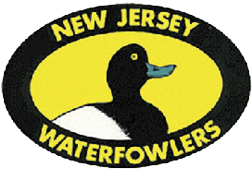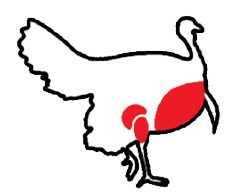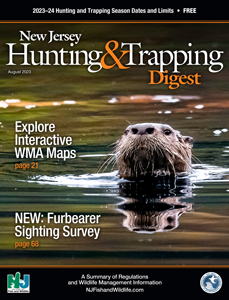Migratory Bird Regulations
Regulations in red are new this year.
New Jersey Migratory Bird Regulations |
|||||||
Species or Season |
Hunting Hours |
Maximum Shot Shell Capacity of FirearmA |
Nontoxic Shot |
Electronic Calls |
HIP Certification |
NJ Stamp Certification |
Federal Stamp |
Ducks, brant, mergansers, coot, 'Regular and Special Winter Season' Canada goose, and 'Regular Season' light geese. |
1/2 hr before sunrise to sunsetB |
3 |
Y |
N |
Y |
Y |
Y |
September Canada goose |
1/2 hr before sunrise to 1/2 hr after sunset |
7 |
Y |
Y |
Y |
Y |
Y |
Light Goose Conservation OrderC |
1/2 hr before sunrise to 1/2 hr after sunset |
7 |
Y |
Y |
Y |
Y |
Y |
Rails, gallinule, snipe |
1/2 hr before sunrise to sunset |
3 |
Y |
N |
Y |
N |
N |
Woodcock |
Sunrise to sunset |
3 |
ND |
N |
Y |
N |
N |
Crows |
Sunrise to 1/2 hr after sunset |
3 |
ND |
Y |
N |
N |
N |
A Includes chamber and magazine combined. B For example, if sunrise is 6:30 AM and sunset is 5:00 PM, hunting hours for these species is 6:00 AM to 5:00 PM C Conservation Order Permit ($2) also required. Available through Internet sales site. D Although not required, hunters are encouraged to use nontoxic shot. |
|||||||
Major Changes for the 2023–24 Season
- The Canada goose bag limit is increased to 3 birds in the North and South Zones. The bag limit remains at 2 Canada geese in the Coastal Zone.
- The mallard bag limit is increased to 4 birds (no more than 2 hens).
- The brant bag limit is reduced to 1 bird. Hunters should carefully check season dates for brant while duck hunting.
- Hooded mergansers remain part of the aggregate bag limit of 5 mergansers.
- Sea ducks can only be hunted when the regular duck season is open in each zone and are included with the bag limit of 6 ducks.
Veteran / Active Military Waterfowl Hunts
Veterans and Active Military are welcome during two statewide, Veterans/Active Military Hunting Days on Nov. 4, 2023 and Feb. 3, 2024.
See below for details.
Waterfowl Stamps
Both the New Jersey Waterfowl Stamp Certification and Migratory Bird Hunting and Conservation Stamp (Federal Duck Stamp) are required for all waterfowl hunters 16 years and older and must be signed in ink. New Jersey Stamp Certifications are available from license agents and from the Licenses and Permits button on NJ Fish & Wildlife’s website. Federal stamps are available from some U.S. post offices and online at www.fws.gov/birds/get-involved/duck-stamp/buy-duck-stamp.php.
Harvest Information Program (HIP)
All hunters, including Apprentice License holders, must obtain a HIP certification before hunting ducks, geese, brant, coot, woodcock, rails, snipe or gallinules. Hunters may purchase a HIP certification from a License Agent or Online at NJFishandWildlife.com/licensesalessite.htm. Both methods allow hunters to go hunting immediately after registering.
HIP certification should be carried in the hunter’s license holder and are valid from Sept. 1 to April 15 the following year. Information collected for HIP is confidential and used by the U.S. Fish and Wildlife Service for conducting migratory bird harvest surveys.
Migratory Bird Zones
All migratory bird zones are described in detail at dep.nj.gov/njfw/hunting/migratory-bird-hunting-zones-and-closure-areas/
Migratory Bird Seasons, 2023–24 | |||
Migratory Bird Species | Season Dates | Daily Bag Limits1 | |
North Zone | |||
Ducks, Mergansers and Coot | Oct. 14–Oct. 21 Nov. 11–Jan. 11 | Ducks: 6 in aggregate; see Duck Limits* below; Mergansers2: 5 Coot: 15 | |
Scaup | Oct. 14–Oct. 21 Nov. 11–Dec. 19 | 1 | |
Dec. 20–Jan. 11 | 2 | ||
Brant | Nov. 11–Nov. 25 Dec. 23–Jan. 11 | 1 | |
Canada Geese (Regular Season) — Singly or in aggregate to include Cackling and White-fronted Goose | Nov. 18–Nov. 25 Dec. 16–Jan. 29 | 3 | |
Youth-only Waterfowl Day | Oct. 7 | See footnote3 | |
South Zone | |||
Ducks, Mergansers and Coot | Oct. 21–Oct. 28 Nov. 18–Jan. 18 | Ducks: 6 in aggregate; see Duck Limits* below; Mergansers2: 5 Coot: 15 | |
Scaup | Oct. 21–Oct. 28 Nov. 18–Dec. 26 | 1 | |
Dec. 27–Jan. 18 | 2 | ||
Brant | Oct. 21–Oct. 28 Nov. 18–Dec. 14 | 1 | |
Canada Geese (Regular Season) — Singly or in aggregate to include Cackling and White-fronted Goose | Nov. 18–Nov. 25 Dec. 16–Jan. 29 | 3 | |
Youth-only Waterfowl Day | Oct. 14 | See footnote3 | |
Coastal Zone | |||
Ducks, Mergansers and Coot | Nov. 9–Nov. 11 Nov. 23–Jan. 27 | Ducks: 6 in aggregate; see Duck Limits* below; Mergansers2: 5 Coot: 15 | |
Scaup | Nov. 9–Nov. 11 Nov. 23–Jan. 4 | 1 | |
Jan. 5–Jan. 27 | 2 | ||
Brant | Nov. 23–Dec. 2 Dec. 14–Jan. 6 | 1 | |
Canada Geese (Regular Season) — Singly or in aggregate to include Cackling and White-fronted Goose | Nov. 9–Nov. 11 Nov. 23–Jan. 27 | 2 | |
Youth-only Waterfowl Day | Oct. 28 | See footnote3 | |
*Ducks Limits – 6 ducks in aggregate and may not include more than:
| |||
Special Sea Duck Area
Waters of the Atlantic Ocean seaward from the International Regulations for Preventing Collisions at Sea (COLREGS) Demarcation Lines (jetty and inlet mouths). For more detailed information see: njdep.maps.arcgis.com/apps/webappviewer/index.html?id=bb6f4b9488d94933bbce24b0fc800760. To aid in safety and to conserve birds, crippled birds may be shot from craft under power in the Special Sea Duck Area only.
Special Winter Canada Goose Season Hunting Areas
The two hatched areas are open to hunting. Visit njdep.maps.arcgis.com/apps/webappviewer/index.html?id=4bc7b1944d9f46239c6f926a3c780048 for detailed Special Winter Canada Goose Season hunting areas and all migratory bird hunting zone boundaries.

Migratory Bird Statewide Seasons |
|||
Migratory Bird Species |
Season Dates |
Daily Bag Limits1 |
|
Canada Geese (September Season) |
Sept. 1–Sept. 30 |
15 |
|
Light Geese - Regular Season4 |
Oct. 17–Feb. 15 |
25, singly or in aggregate |
|
Light Geese - Conservation Order4 |
Feb. 16–Apr. 6 |
No limit |
|
Rail (Sora, Clapper and Virginia) and Gallinule |
Sept. 1–Nov. 21 |
Sora & Virginia rail: 25 total or aggregate; Gallinule:1; Clapper rail: 10 |
|
Snipe |
Sept. 9–Jan. 11 |
8 |
|
Crow |
Aug. 14–Dec. 2 Dec. 11–Mar. 16 Mon., Thur., Fri., Sat. Only |
No limit |
|
Youth and Veterans/Active Military Day |
Feb. 3 |
See footnote3 |
|
Veterans/Active Military Only Day |
Nov. 4 |
See footnote3 |
|
Other Migratory Bird Seasons |
|||
Migratory Bird Species |
Season Dates |
Hunting Hours |
Daily Bag Limits1 |
Woodcock - North Zone |
Oct. 14–Oct. 28 Oct. 31–Nov. 25 |
Sunrise to sunset |
3 |
Woodcock - South Zone |
Nov. 11–Dec. 2 Dec. 14–Jan. 2 |
Sunrise to sunset |
3 |
Sea Ducks (Black, Surf and White-winged Scoter; Long-tailed Duck and Eider only) |
Same as ducks by zone. Crippled birds may be shot from craft under power in the Special Sea Duck Area ONLY. |
Not more than 4 sea ducks (not more than 3 scoters, 3 long-tailed ducks or 3 eiders [no more than 1 hen eider]), within total bag of 6 ducks. |
|
Canada Geese (Special Winter Season Areas) — Singly or in aggregate to include Cackling and White-fronted Goose |
Jan. 30–Feb. 15 |
1⁄2 hr before sunrise to sunset |
5 |
Swans, harlequin duck, king rail, sandhill crane and mourning dove |
Closed |
None |
|
New Jersey Waterfowlers Clinic
Every year, experienced waterfowlers throughout New Jersey join together dedicating their time and energy to present the New Jersey Waterfowlers Clinic—an all day, free seminar covering “everything you ever wanted to know” about the traditions of waterfowl hunting in New Jersey. This year is no exception!
Forty years ago, the clinic began as an opportunity to introduce young people to the world of waterfowl hunting. However, with the growing interest among men and women, as well as youths, the event has been transformed into an opportunity for anyone 10 and up to spend a fun and interesting day learning about waterfowling!
Our full-day clinic covers waterfowling from A to Z, and includes bird identification, decoys, calling, guns and ammo, boats, safety, laws and ethics, do’s and don’ts, clothing and camo, and even a demonstration by working retrievers! The value of the day is priceless! It’s a unique chance to ask any question you’ve ever had about the sport—to be answered by the most experienced waterfowlers in New Jersey. Our instructors have a combined 300 years of experience!
- Free breakfast and lunch for all attending!
- Date: Sunday, Oct. 8, 2023
- Location: Tip Seaman Park, Tuckerton, NJ
- Time: 8:00 a.m. – 3:30 p.m.
Please register in advance by calling Marty Kristiansen at (732) 977-5648 so we can plan accordingly.
We hope you’ll join us this year and share our enthusiasm for all that is waterfowling!

Waterfowl Blinds
No permanent waterfowl blinds, including pit blinds, shall be constructed, hunted from or used in any manner on these WMAs:
- Assunpink
- Black River
- Colliers Mills
- Hainesville
- Tuckahoe
- Manahawkin
- Stafford Forge
- Whittingham
- Beaver Swamp
- Sedge Island
- Salem River
- Prospertown
- Paulinskill
Any blind used on these WMAs must be portable and completely removed by day's end. Blinds remaining on WMAs are subject to confiscation and disposal by Fish and Wildlife.
Hunters: Report Banded Birds
Hunters who recover banded migratory birds are asked to report the band number to the U.S. Department of the Interior’s Bird Banding Laboratory (BBL), Washington, D.C. Banding data plays a critical role in migratory bird harvest management. There are two ways to report bands:
- Online: ReportBand.gov
- Write: to the address inscribed on the band.
Online reporting provides instant access to the original banding information including the species, sex, location, date and age of the bird at banding. Band reporters will be able to print a certificate of appreciation on their home computer which will include information about the bird which had been banded.
When contacting the BBL, be prepared to provide: band number, date the bird was recovered, exact location of the bird’s recovery as well as nearest town, and method of recovery, e.g., shot or found dead. Hunters may keep the bands.
Summary of Federal Regulations
The following is a synopsis of Federal Regulations that pertain to the hunting of migratory game birds. More information can be found at: dep.nj.gov/wp-content/uploads/njfw/waterfowl_federal_regs.pdf or by calling the U.S. Fish and Wildlife Service Law Enforcement Office at (908) 787-1321.
No persons shall take migratory game birds:
- By the aid of baiting, or on or over any baited area, where a person knows or reasonably should know that the area is or has been baited. Baiting means the direct or indirect placing, exposing, depositing, distributing, or scattering of salt, grain, or other feed that could serve as a lure or attraction for migratory game birds to, on, or over any areas where hunters are attempting to take them. Baited area means any area on which salt, grain, or other feed has been placed, exposed, deposited, distributed, or scattered, if that salt, grain, or other feed could serve as a lure or attraction for migratory game birds to, on, or over areas where hunters are attempting to take them. Any such area will remain a baited area for ten days following the complete removal of all such salt, grain, or other feed.
- With a trap, snare, net, rifle, pistol, swivel gun, shotgun larger than 10 gauge, punt gun, battery gun, machine gun, fish hook, poison, drug, explosive, or stupefying substance;
- With a shotgun of any description capable of holding more than three shells, unless it is plugged with a one-piece filler, incapable of removal without disassembling the gun, so its total capacity does not exceed three shells. Exceptions: In New Jersey, shotguns capable of holding no more than 7 shells are permitted during the September Canada goose season and the Light Goose Conservation Order.
- From or by means, aid, or use of a sinkbox or any other type of low floating device, having a depression affording the hunter a means of concealment beneath the surface of the water;
- From or by means, aid, or use of any motor vehicle, motor-driven land conveyance, or aircraft of any kind, except that paraplegics and persons missing one or both legs may take from any stationary motor vehicle or stationary motor-driven land conveyance;
- From or by means of any motorboat or other craft having a motor attached, or any sailboat, unless the motor has been completely shut off and/or the sails furled, and its progress there from has ceased. Exception: crippled birds may be shot from craft under power in the Special Sea Duck Area.
- By the use or aid of live birds as decoys; although not limited to, it shall be a violation of this paragraph for any person to take migratory waterfowl on an area where tame or captive live ducks or geese are present unless such birds are and have been for a period of 10 consecutive days prior to such taking, confined within an enclosure which substantially reduces the audibility of their calls and totally conceals such birds from the sight of wild migratory waterfowl;
- By the use or aid of recorded or electrically amplified bird calls or sounds, or recorded or electrically amplified imitations of bird calls or sounds. Exceptions: In New Jersey, hunters can use electronic calls during: crow season, September Canada goose season and the Light Goose Conservation Order.
- By means or aid of any motor driven land, water, or air conveyance, or any sailboat used for the purpose of or resulting in the concentrating, driving, rallying, or stirring up of any migratory bird.
Tagging requirement—No person shall put or leave any migratory game birds at any place (other than at his personal abode), or in the custody of another person for picking, cleaning, processing, shipping, transportation, or storage (including temporary storage), or for the purpose of having taxidermy services performed, unless such birds have a tag attached, signed by the hunter, stating his address, the total number and species of birds, and the date such birds were killed. Migratory game birds being transported in any vehicle as the personal baggage of the possessor shall not be considered as being in storage or temporary storage.
Custody of birds of another—No person shall receive or have in custody any migratory game birds belonging to another person unless such birds are properly tagged.
Species identification requirement—No person shall transport within the United States any migratory game birds, except doves and band-tailed pigeons, unless the head or one fully feathered wing remains attached to each such bird at all times while being transported from the place where taken until they have arrived at the personal abode of the possessor or a migratory bird preservation facility.
New Jersey State Regulations
State laws and regulations may be more stringent but not more lenient than those prescribed in federal regulations (50 CFR Part 20). See General Hunting Regulations.
Restrictions:
- Migratory bird hunting is not permitted on Sunday in New Jersey.
- No person may take rails or snipe while possessing shot other than non-toxic shot.
- The starting time to hunt waterfowl on opening day of pheasant season (Nov. 11, 2023) is 8 a.m. on wildlife management areas stocked with pheasant and quail except the tidal waters or marshes of those WMAs. See Upland Game Birds for pheasant and quail stocked WMAs. The starting time to hunt waterfowl on opening day of the pheasant season conforms to the regular start time (e.g. 1⁄2 hr. before sunrise) on private land, tidal marshes, WMAs not stocked with pheasant and quail, and the tidal marsh portions of pheasant and quail stocked WMAs.
- There shall be no open season for hunting any game birds or animals including migratory waterfowl:
- In or on the shores of the Shark River in Monmouth County.
- In that portion of the Manasquan River from the ocean inlet upstream to Route 70 bridge.
- On Herring Island and that portion of Barnegat Bay lying between northern and southern tips of Herring Island easterly to adjacent shoreline of Mantoloking Boro, Ocean County.
- On Parker Creek and Oceanport Creek, Monmouth County, or the shores thereof, southwest or upstream of the Conrail R.R. bridge.
- On the non-tidal portions of Cox Hall Creek WMA in Cape May County.
- In the waters or shoreline of Barnegat Inlet westward from the COLREGS Demarcation Line; to the north end of Broadway in Barnegat Light; then northwest to Red Buoy 14 in the channel (39.763783 N; 074.109283 W); then northeast to the westernmost section of rock jetty at Island Beach State Park. These areas are also explicitly mapped in the Hunting & Trapping Explorer: NJFishandWildlife.com/hunt.
- It is unlawful for any person to leave the edible portions (defined as the breast meat) of migratory birds (excepting crows) to waste. Edible portions (see illustration, below) do not include meat that has been damaged by the method of taking; bones, sinew and meat reasonably lost as a result of butchering, boning, or close trimming of bones; or viscera.
- Waterfowl hunting on Delaware River is governed by state boundaries and restricted to respective state seasons.
- Permanent blinds may not be constructed on some state wildlife management areas.
- Arrows with flu-flu type fletching are required for taking flying game birds. Arrows with edged heads are prohibited for taking flying game birds.
Edible portions do not include meat from the head or neck; meat that has been damaged by the method of taking; bones, sinew, and meat reasonably lost as a result of butchering, boning, or close trimming of bones, or viscera. Edible portions do not include meat from diseased or scavenged carcasses. See Wanton Waste of Game in General Hunting Regulations.

For rabbit and squirrel:
- Front shoulders
- Thighs
- Backstrap

For game birds such as turkey:
- breast, legs and thighs

For game birds other than turkey:
- breast
Spring Light Goose Conservation Order
The NJ Light Goose Conservation Order Permit will be available January 2024 ONLY from the Internet sales site. As part of the permit process, hunters will be required to report their activity and harvest as requested on the permit. Check NJ Fish & Wildlife's website in late winter for more details.
Falconry—Special season dates and bag limits apply. Contact Fish and Wildlife at (908) 735-6938.
Tuckahoe WMA Managed Waterfowl Hunt
As part of NJ Fish & Wildlife’s R3 Program’s initiative to Recruit, Retain and Reactivate hunters, a plan was presented to implement the State's first managed waterfowl hunts at the Tuckahoe Wildlife Management Area (WMA). In September of 2019, the Fish and Game Council approved this new opportunity on the heels of a cooperative, five-year habitat restoration project that was completed during the winter of 2017-18. Due to a delay from Covid-19, the program was started in the fall of 2021.
Managed waterfowl hunting opportunities are a common practice across the country that seek to maximize waterfowl use and provide a quality hunting experience. This is done by providing an attractive forage base for waterfowl and reducing the disturbance waterfowl experience by limiting hunting pressure.
The objectives of this plan are to:
1) Improve the overall quality of waterfowl hunting at the Tuckahoe WMA impoundments.
2) Provide an opportunity for newly recruited or less experienced waterfowl hunters.
3) Provide new and improved experiences for current waterfowl hunters.
4) Provide an opportunity that alleviates access and overcrowding constraints that negatively impact waterfowl hunters' experiences.
How to Apply:
A lottery application process will be in effect to access hunting blinds and delineated hunting zones established at the three Tuckahoe impoundments. There will be NO FEE associated with the application process. A decoy loaner program will be available for those new to waterfowl hunting, as needed. A current license, HIP Certification, and state and federal stamps are required.
For more information please visit dep.nj.gov/njfw/hunting/tuckahoe-wildlife-management-area-managed-waterfowl-hunt/ or email [email protected]
Veterans/Active Military Waterfowl Hunting Days
Nov. 4, 2023 — Statewide Veterans & Active Military Day
Feb. 3, 2024 — Statewide Joint Veterans & Active Military and Youth Waterfowl Hunt Day
The U.S. Fish and Wildlife Service allowed states to choose special hunting days for Veterans and Active Military personnel in recognition of their service to our country. Waterfowl hunting outside the regular season is allowed on the day(s) officially designated as “Veterans/Active Military Waterfowl Day.” New Jersey has two Veterans/Active Military Hunting Days, one of which runs concurrent with a special Youth Hunting Day.
Active Military includes members of Armed Forces on active duty, including National Guard and Reserves (other than active duty for training). Veterans includes those who served in the active military, naval or air service and who were discharged or released therefrom under conditions other than dishonorable. Participants in Veterans/Active Military Waterfowl Hunting Days must carry while hunting one of the documents which applies to their status to be eligible to participate:
- Active military identification card
- Copy of honorable discharge certificate DD-214
Participants must have a hunting license, HIP certification, and state and federal duck stamps. Bag limits for these days include ducks, geese, brant, mergansers, coots and gallinules. Bag limits are the same as those allowed in the regular season in each zone except the scaup limit is 2 per day.
FAQs for special Veteran/Active Military and Youth Hunt days:
dep.nj.gov/njfw/hunting/special-youth-and-veterans-active-military-waterfowl-hunting-days-faqs/
Youth Waterfowl Hunting Days
Youth hunters must possess a valid Youth Firearms License—OR be less than 16 years of age and qualified to hunt without a license under the farmer license exemption (see Licenses, Permits & Fees)—to hunt the Youth Waterfowl Hunting Days as detailed in Take A Kid Hunting.
Nontoxic Shot Regulations
In New Jersey, no person may take ducks, geese, brant, coots, rails, snipe or moorhens while possessing shot other than approved non-toxic shot which includes: steel, tungsten-iron, tungsten-polymer, tungsten-matrix, tungsten-nickel-iron, tungsten-iron-nickel-tin, tungsten-bronze, tungsten-iron-polymer, bismuth-tin, copper-clad iron, tungsten-iron-copper-nickel, tungsten-tin-iron, corrosion-inhibited copper shot, and tungsten-tin-bismuth shot types. Shot size may not exceed Size T (0.200 inch) for waterfowl. See https://www.ecfr.gov/current/title-50/chapter-I/subchapter-B/part-20#p-20.21(j)(1) for more information. For crows and woodcock, shot size may not exceed Size #4 and although lead shot is permitted, hunters are encouraged to use non-toxic shot.


